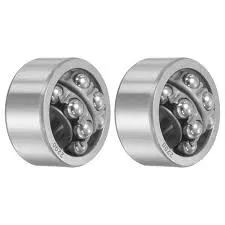
Nov . 21, 2024 11:36 Back to list
tapered roller bearing cup and cone
Tapered Roller Bearing Cup and Cone An Overview
Tapered roller bearings are widely used in various industries due to their ability to support heavy loads while allowing for efficient rotation. They are distinguished by their unique design, which comprises two main components the cone and the cup. Understanding the functionality and application of these components can provide valuable insights into the effectiveness of tapered roller bearings in machinery and automotive applications.
Structure and Design
The cone and cup of a tapered roller bearing are designed to work together seamlessly. The cone is the inner part of the bearing, featuring a cone-shaped raceway where the rollers make contact. The rollers themselves are also taper-shaped, allowing them to distribute loads more evenly across the contact surface. This design minimizes the risk of wear and tear, ensuring a longer service life for the bearing.
The cup, on the other hand, is the outer race of the bearing that houses the rollers. It has a matching tapered surface that allows the rollers to be neatly seated within. This tapered geometry means that when a load is applied, the rollers are forced against the raceways, enhancing the bearing’s load-carrying capacity.
Functionality
One of the primary advantages of tapered roller bearings is their ability to accommodate both radial and axial loads. The contact angle, which is determined by the geometry of the cone and cup, enables the roller bearings to support thrust loads while maintaining stability against radial forces. This combination makes them a popular choice in applications such as vehicle wheel hubs, gearboxes, and heavy machinery.
When the bearing is in operation, the rolling action of the tapered rollers within the cup reduces friction significantly compared to traditional sliding bearings
. This reduction in friction not only facilitates smoother operation but also contributes to energy efficiency, as less energy is wasted in overcoming resistive forces.tapered roller bearing cup and cone

Applications
Tapered roller bearings are ubiquitous in the automotive industry, particularly in axle and wheel arrangements. They are essential for ensuring responsive handling and performance in vehicles, from passenger cars to heavy trucks. Additionally, these bearings are integral to various other applications, including construction equipment, agricultural machinery, and industrial transport systems.
In manufacturing environments, tapered roller bearings are utilized in conveyor systems, electric motors, and gearboxes. Their robust performance under load and low maintenance requirements make them ideal for applications that demand high reliability.
Maintenance and Considerations
While tapered roller bearings are designed for durability, proper maintenance is essential to maximize their lifespan. Regularly inspecting the bearing for signs of wear, ensuring adequate lubrication, and monitoring for any unusual noises can help in maintaining optimal performance. Bearing preload, which impacts the clearance and operational performance, should also be carefully managed during installation.
Conclusion
In summary, tapered roller bearings, with their distinct cone and cup design, play a crucial role in enhancing the efficiency and reliability of machinery across various sectors. Their unique ability to handle both radial and axial loads makes them indispensable in automotive and industrial applications alike. As technology continues to evolve, innovations in bearing design and materials will likely enhance the performance and longevity of tapered roller bearings, ensuring their continued importance in modern engineering.
Latest news
-
Durable Greenhouse Pillow Block Bearings for Reliable Ventilation
NewsAug.31,2025
-
Spherical Roller Bearings Applications: Heavy Duty, Self-Aligning
NewsAug.30,2025
-
Premium Deep Groove Ball Bearings | High Speed & Reliability
NewsAug.29,2025
-
Durable Scaffolding Clamps - Secure & Reliable Tube Connectors
NewsAug.28,2025
-
Common Failures in Thrust Ball Bearings and Solutions
NewsAug.22,2025
-
How Tapered Roller Bearings Can Take Shock Loads
NewsAug.22,2025
